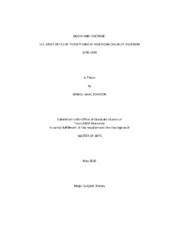| dc.description.abstract | While academics and commentators have devoted considerable energy to analyzing the relationship between United States military casualties and the reaction of American public opinion, few have taken notice of the opinions and perceptions of military officers. U.S. Army officers, comprising the bulk of the American military leadership, sustained a thorough debate concerning casualties and public opinion between 1970 and 1999. That debate is apparent from a study of articles in the military's professional journals, contributions to scholarly journals, memoirs, and monographs emerging from the various service schools.
Examining the material generated by officers during these decades reveals that they perceived a trend - as well as disclosing a trend in their own writing and discussions. Shaken by the experience of the Vietnam War, unsettled by the public's rejection of that war, officers struggled to prepare for future wars. In the thirty years under discussion, U.S. Army officers noticed an emphasis on technology intended to be more lethal to the enemy and to provide more protection for the American soldier. Officers observed a doctrinal trend beginning with conserving scarce manpower, escalating to minimizing casualties, and reaching the establishment of force protection as a mission equal to any in a given operation. American officers perceived that their political and military leadership had first grown wary of spending American lives and gradually came to view casualties as synonymous with defeat. Associated with this phenomenon, officers noted that in many cases - increasing as this era advanced - sustaining casualties below a given threshold marked the operation as a victory. In sum, military officers observed a trend in which America's civilian and military leadership strived to avoid sending men into conflict, attempting to mitigate through technology the risk combat posed to soldiers, and reacting to casualties as if they signified military defeat. | en |


